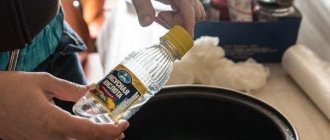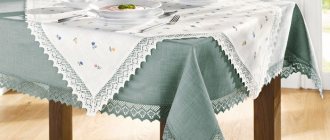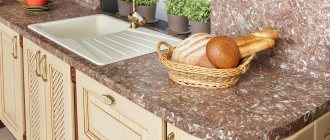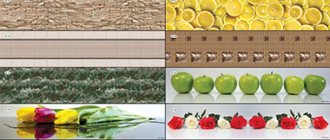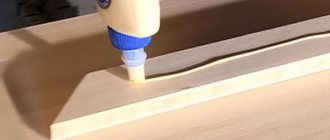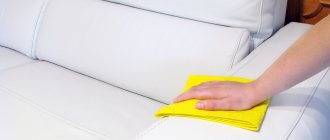Types of stains and their differences
Water stain (migratory stain).
The base is water. Thinner: water. No smell
- Easy to apply
- Gives uniform color
- More economical than solvent-based stains
- Slow drying
- Penetrates deeply into the wood texture
- Raise the pile
- The subsequent applied layers of aqueous materials migrate (color). To prevent the process of migration (staining), it is necessary to carefully fix the water-based stain with any non-aqueous varnish.
- If applied intensively, they can saturate the wood with moisture and deform it.
Alcohol stain (stain). Thinner: alcohol, acetone.
- Dries quickly
- Doesn't raise the pile
- They do not migrate after drying, i.e. allow you to work with any water-based materials over a tinted surface.
- Penetration into the wood structure is not as deep as with water-based stains, which simplifies the work of additionally highlighting the wood structure with abrasive materials.
- do not saturate wood, do not cause swelling of fibers.
- have a pronounced alcohol smell, and natural colors have a strong acetone smell. It is recommended to work in a well-ventilated area.
Universal stain (stain). Thinner - water, alcohol, acetone.
- It has all the properties of water stains (see above). The thinner alcohol or acetone only allows the stain to dry faster on the surface.
- BE CAREFUL!!!! Even if you dilute the universal stain with alcohol or acetone, without intermediate varnish the STAIN WILL MIGRATE!!!
Magazine "Furniture Factory" No. 4, 2010, pp. 58-61: Wood tinting
Toning is often the most important and complex technological operation in the transparent finishing of solid wood or veneer. The tinting composition is applied directly to the wood and, interacting with it, gives a variety of decorative effects. The aesthetic features of the products largely depend on this operation. Currently, there is a wide variety of tinting compositions that allow you to achieve one or another depth of color, transparency, obtain different color surface textures, and an original “speckle”. In the highly competitive furniture market of Russia, you can significantly increase the demand for products by guessing which “speckle” is in fashion.
Wood tinting has a long history; many appropriate methods and materials have been created, but today in the industrial production of furniture and interior doors, tinting of three main groups is widely used: stains, stains, glazes .
Stains
Stain is a material that makes wood look like stained wood, that is, it gives a tint to the wood itself, impregnating its fibers. After tinting with stain, the color of the wood becomes saturated and the texture becomes pronounced. The stain does not create a continuous varnish film on the surface of the wood. This type of tinting is traditional for the Southern European school of wood finishing, in particular Italian. Two types of stains are widely used: texture-emphasizing and leveling (sometimes the term “harmonizing” is used).
Highlighting stains are a classic type of stain that provide deep penetration. Such stains are solutions of dyes and do not contain binders or resins intended to fix dyes on wood. Dissolved dyes penetrate the wood together with the carrier solvents and are retained in microcapillaries, microcavities about hundredths of a micron in size. Thus, highlighting stains provide volumetric rather than superficial coloring of wood, without veiling the texture, without a grayish tint, which sometimes occurs when binder resins are present in the composition. Of course, areas of the wood grain that are more absorbent, the early layers of growth rings absorb more stain and acquire a richer color. The tone of such areas becomes darker. Emphasizing stains reveal not only the structure of annual rings and flakes, but also visually highlight individual fibers on the surface of the wood.
When emphasized moderately under a silky clear varnish, wood with an accentuating stain can shine with an inner light. This tinting looks most natural on species that do not have a pronounced color texture, for example, on birch or on poorly absorbent species (oak, ash). For example, in Fig. Figure 1 shows a finish using TMM006 highlight stain from Renner Italia on birch, oak and beech. The effect of emphasizing texture depends largely on the thinner used to dilute the stain concentrate to the desired color intensity, and on the technique of applying the stain. Diluting the stain with a slow thinner, applying it with pneumatic spray with a too “wet” torch, and even on wood with high absorbency, can lead to excessive emphasis. As a rule, the so-called negative effect is considered undesirable, in which the initially lighter areas of the early wood of the growth rings become darker.
Recommendations for applying stains
- Before applying stain, sand the surface thoroughly. It is necessary to work with an abrasive material along the grain of the wood; scratches across the grain will be emphasized by the stain and will stand out. The different tone of the stain (different absorbency) will depend on the grain size of the abrasive.
- Before painting an object, it is better to do a test painting. The painting is done on the same material from which the product is made. The result of the surface color is assessed only after complete drying and varnishing, because the color changes significantly.
- When using water-based stains, it is recommended to pre-treat the wood with water. And after drying, sand off the raised pile. Then, after applying water stain, the raising of the pile will be minimized.
- To apply stains to a large, flat surface, it is better to use the widest brush possible.
- It is better to apply the stain liberally and evenly, always along the grain. It is very important to have time to combine wet edges, so with stains, especially alcohol stains, you need to work quickly and without interruptions.
- For a more even application of alcohol stains on large surfaces, you can use a special “Polishing Glaze”, which increases the drying time of the alcohol stain and allows you to spread it over the surface without leaving any traces of joints.
- Since stains are very fluid for processing vertical surfaces and turning products, it is better to use a paint pad, foam rubber or any rag.
Oil-based stain for wood
Scope of application: for treating external and internal wooden surfaces (walls, ceilings, fences, gazebos, furniture, etc.) Product Description: Oil-based wood stain (stain) is intended for tinting and deep impregnation of wood. Emphasizes the texture of wood. Suitable for processing all types of wood. Resistant to UV rays. Convenient to apply. Ingredients: mixture of natural vegetable oils, dearomatized gasoline, fragrance, pigments, UV filter. Physical properties: Mass fraction of non-volatile substances –% Viscosity: 11 seconds according to VZ 246 Density: 0.8 cm3 Odor: Shelf life and conditions: 5 years from the date of manufacture. Store in a tightly closed container in a cool, dry place. Not afraid of freezing. At negative temperatures it does not lose its properties. Surface preparation: the surface to be treated must be clean, dry (wood moisture content should not exceed 25%) and not frozen. If necessary, clean the surface to be painted from dirt and old paintwork. Fill small seams and cracks with wood putty. Depending on the properties of the surface being processed, select the optimal grinding mode (grain size from 80 to 240). Sand and thoroughly remove dust. For processing ceilings and walls made of lining indoors, it is allowed to use stain without sanding. For additional protection of surfaces from biological damage, pre-treatment with Sigma series antiseptic primers is recommended. To renew darkened wood as a result of exposure to atmospheric factors, it is recommended to clean the surface using Sigma Oxygen oxygen bleach. The recommended minimum temperature for applying the composition is +15°C. Method of application: Before use and during operation, mix the composition thoroughly, as pigments tend to settle to the bottom of the container. To reduce pigmentation of the composition, dilution with Antiseptic “Sigma Soil Base” . Apply a thin layer along the wood grain using a brush, stiff bristle brush, lint-free cloth or spray gun. Spread evenly over the surface. Leave to dry with good ventilation. To protect the surface from abrasion, use oil-wax compositions from the Sigma series as a finishing coating. When applying over large areas, it is recommended to use polishing machines with a white pad. The result of painting will depend on the properties and degree of preparation of the wood, so it is recommended to test paint a sample. Maximum coating strength is achieved after 7-14 days. Drying time: 7-10 hours at a temperature of 20°C and a relative humidity of 50%. Low temperatures and high humidity increase drying time. Consumption: 30-45g/m2 for a single layer coating. Consumption depends on the properties, structure and preparation of the surface, method of application, as well as the qualifications of the technician. Recommendations for care: Do wet cleaning with a well-wrung out cloth. Do not use very hot water or aggressive detergents. For additional care during wet cleaning, it is recommended to use the Carnauba Wax Emulsion product. Cleaning the tool: upon completion of work, the tool is washed with warm soapy water. Safety recommendations: Keep out of reach of children! Use personal protective equipment. Fire safety rules in the workplace must be followed. After use, rags and other textile materials impregnated with the composition must be immersed in a container of water due to the risk of spontaneous combustion. Disposal: Dry empty containers must be disposed of as household waste. Container volume: 0.03l, 0.125l, 0.5l, 1l, 3l. Vendor code:
General characteristics of ProArt stains:
- All ProArt stains are concentrates that can and should be diluted to the desired saturation. When using concentrates in their pure form, the result is a strong, extremely dark or saturated color from one coat of coating.
- Subject to storage rules, the shelf life of stains is unlimited.
- Before use, be sure to thoroughly mix the stain to achieve uniformity of the material.
- All stain colors of one base mix perfectly with each other to obtain the desired color and shade.
ArtBlank.
What is stain
This is a tinting agent that is used to change the shade of wood. It does not form a film and does not change the properties of the material in any way. Provided that no special substances are added to it. These can be antiseptics, etc. The solution is absorbed and colors only the surface layer of the material. The texture and relief of the surface are completely preserved. The colors of wood stain can be very different.
The product is widely used for decorative purposes. With its help, you can transform the most inexpressive types of wood without much expense, emphasizing their texture and relief. Various shades are available for decoration. You can choose natural tones or use green, blue and any other colors. Examples can be seen in photos on the Internet. An interesting effect is achieved by mixing shades, which is achieved by layer-by-layer application of mixtures of different tones.
Stain, or stain as it is also called, can be used not only as decoration. When special preparations are added, it can protect the wood from rotting, give it additional strength or hardness, etc. This is very convenient, since the universal drug solves several problems at once.
Application to wood
A good effect from using stain can only be achieved if it is applied correctly to a wooden surface.
But before applying stain, it is important to properly prepare the surface. The main actions at the preparatory stage are:
- Sanding a wooden surface.
- Preliminary degumming of the surface so that the impregnation can penetrate deep into the wood.
- Degreasing the surface and cleaning it from dirt and dust.
When the surface is prepared, you can proceed directly to staining:
- The stain is slightly warmed before application. This allows it to penetrate deeper into the wood.
- A brush, rag or swab is moistened with stain. It is important to ensure that there is no excessive wetting, as this can lead to drips and uneven application.
- The product must be applied along the wood fibers. In this case, movements must be performed quickly and continuously to avoid stains. If the appearance of drips still cannot be avoided, then excess liquid on the surface can be neutralized using a soft cloth that will absorb excess stain.
- To obtain the desired shade, the stain is applied to the surface in several layers. It is important to wait until the previous layer has completely dried.
- The final step is to apply varnish and sand the surface with fine-grained sandpaper.
How long does it take for different types of stains to dry?
From the information presented above, it is clear that different types of stains are characterized by different drying times.
Water-based paints dry on average 12-14 hours after application to a wooden surface.
Alcohol dries almost instantly. At low temperatures and high humidity, drying time can reach half an hour.
Oil-based ones dry on average 2-4 days after application.
Nitro stains and wax stains, like alcohol stains, dry quickly.
Stain processing methods
In order to make wood products more decorative and aesthetically pleasing, certain rules and techniques should be followed when processing with stain.
An important role in the quality of the final result is played by the tools with which the dye will be applied. And in this situation, water stains also have some superiority. If quick-drying alcohol-based compositions require a spray gun, and luxury acrylic ones require a wide brush with natural bristles, all you need is an inexpensive foam roller or a brush with synthetic bristles. For small surfaces, a simple foam swab is also suitable.
When working with a brush, it is very important not to go into adjacent areas already painted with stain. Failure to follow this simple rule can cause uneven coloring, streaks and stains.
Today, there are two generally accepted methods of treating wood with stain:
- Apply the composition generously, followed by removing excess liquid with a swab.
- Copious application of dye without removing excess.
The first method of processing is in demand for stains on water. It allows you to remove streaks and stains, smooth out color transitions, and achieve the desired lighter shade.
The second method is relevant for solvent-based stains that provide deep, rich tones. Although sometimes during the work it is also necessary to remove excess composition in order to prevent the formation of defects.
Paint injection tank ValSpray AT 10-20-40-60 Economic
- manufacturer: ValSpray
- type of work: production of windows and doors, painting of metal structures, exterior work, interior work, furniture manufacturing
The ValSpray AT 10-20-40-60 Economic pressure tank with adjustable product pressure and an internal removable stainless steel liner ensures stable operation and material consumption with compositions of any viscosity. Maximum pressure - 4.5 bar. ...
more details
in stock from
€583.79
Low pressure diaphragm pump VS 36
- manufacturer: ValSpray
The low pressure diaphragm pump VS 36 is the ideal solution for professional industrial painting. Thanks to its small dimensions, it is ideal for both stationary and mobile painting stations, for powering...
more details
in stock
€583.79
Dealing with defects
The most common defects that significantly spoil the quality of the stain finish are stains and drips. Most often they accompany the actions of beginners and careless artists who forget that a small amount of stain on the brush and applying a thin layer of coating is the best way to prevent drips and the formation of blots. Correcting annoying mistakes is much more difficult than avoiding them.
It is impossible to wash off stain stains from wood, so defects can be eliminated using sandpaper or a plane. By carefully removing thin shavings and smoothing out the transitions in the problem area, you can get rid of the flaws.
Deficiencies in finishing can also arise as a result of poor preparation of the wooden surface. A good stain will not decorate furniture or other wood products if the sanding is poorly done or if there are remaining grease and tar stains. The work will have to start from scratch, from preparation to painting.
To ensure that your efforts are crowned with success, when purchasing stain in the TBM-Market online store, ask questions to a company specialist. He will advise, prompt, help you understand the intricacies of staining and make a choice.
Water stain for wood
|
|
Processing methods
Depending on why the stain is needed, different coating methods are used with different tinting results. Typically, processing is carried out with a brush or roller.
However, the best effect is obtained by spraying, rubbing, dipping and a combination of methods:
- Spraying achieves rapid drying and settling of pigments on the surface layer.
- Rubbing - the parts are generously coated with the solution, while simultaneously rubbing the stain into the surface. Emphasizes the wood texture, but does not even out the tone.
- The combined method, when the composition is first rubbed in and then sprayed, creates a harmonious effect of uniformity and the appearance of wood grain.
Ends and sections with increased absorbency require intensive impregnation, for which the stain is applied in layers several times. Excess is wiped off.
Insufficient skill leads to uneven coverage and staining when stained. Therefore, before the main painting, be sure to conduct a color test. What is it and how is it done:
- The selected shade is applied to a board of the same type and polish as the main product. Wait for it to dry.
- Visually divide the board into 3 parts, and 2 of them are covered with a second layer.
- Allow to dry and apply a third layer to 1/3 of the board.
This way you will clearly understand what wood stain is, whether the chosen color is suitable, and how many layers need to be applied.
What is wood stain used for?
The main function of the solution is long-lasting decorative impregnation and protection of products, but there are also additional possibilities. The bases, methods of influencing the surface, and color intensity differ.
- When choosing a composition, consider the following characteristics:
- Transparency. Mixtures can be opaque, partially or completely transparent.
- Wear resistance. For floor coverings, a specialized rustic stain is used.
- Heat resistance. Different impregnations are used for interior and exterior work.
- Moisture protection.
- Additives of antiseptics and fungicides to prevent damage by mold, mildew, and wood-boring insects.
- Fire retardant (fire-fighting) components.
Understanding what stain does to wood, you can achieve complete restoration of outdated wooden products: shade the wood, protect it from external factors, and give valuable things a second life.
Toning
Staining imitates elite breeds without the expense of expensive materials. The largest palette is presented among aqueous solutions. There are 3 color schemes:
- Natural – natural wood shades: maple, walnut, cherry, wenge, oak.
- Neutral - white, gray and black.
- Plain color (red, blue, green, purple), designer selections.
The possibilities for the decorative effect of stain are enormous, up to the point of radically transforming the wood.
